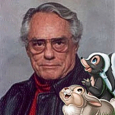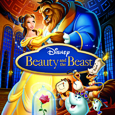Walt Disney Productions (August 21 1942), Walt Disney Home Entertainment (March 1 2011), Blu-ray and DVD discs, 70 mins plus supplements, 1080p original Academy 1.33:1 high-definition, DTS-HD High-Resolution 7.1 and Original Restored Mono, Rated G, Retail: $39.99
Storyboard:
New life arrives in the woods with the birth of little deer Bambi, the new Prince of the forest, who is adopted as a friend by the lively rabbit Thumper, taking it upon himself to teach Bambi about his world. Slowly, Bambi comes to realise that there is much more he has to learn, especially when he meets a young female fawn, Faline, and not least when he must come to respect his father, the Great Prince Of The Forest, and his warnings of the devastating effect of “man” in the forest…
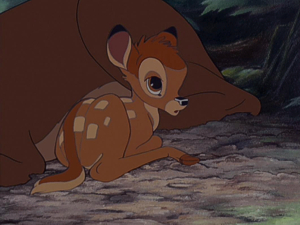
The Sweatbox Review:
Oh deer! It seems Disney’s anniversary-marking department has dropped the ball again, and instead of delaying Bambi’s release until this time next year when it could have celebrated its 70th birthday, the film arrives in a gorgeous new high-definition release without any such distinguishing designation. It’s a small note, to be sure, but it just seems that these landmarks seem to be rather haphazardly recognized by Disney Home Video, who often issue titles a year out of sync with any particular release date milestones. However, we are finally due to be able to soar with Dumbo later this year, for his correct 70th anniversary year (after the rest of the world received a year-early release in early 2010), and whatever the markings – or not – on the packaging, it’s always nice to be reacquainted with Bambi, one of Walt’s most involving features.
If The Little Mermaid was the next generation of Disney artists’ take on the Snow White-styled fairy-tale, Beauty And The Beast the film where they surpassed themselves technically on all levels to create a masterpiece worthy of Pinocchio and Aladdin their knockabout comedy Dumbo, then Bambi would surely rank as being looked upon as the inspiration behind The Lion King. Both stories feature an animal kingdom youngster, who loses a parent and must get over that fact in order to continue living their lives and find their place in the world around them. Bambi, however, handles the whole original “Circle Of Life” theme a little more subtly…

Originally put into production alongside Snow White (it was always an alternative to Walt, should the animating of human figures in that film prove too ambitious at the time), the rights to Felix Salten’s story were purchased in 1936 and artwork development began immediately. The Silly Symphony The Old Mill (found in the supplementary section of the original Platinum Edition, and thankfully carried over here if only in standard definition) was a testing ground for the highly stylised but realistic approach that Walt was striving for. Due to ongoing technical finessing, the Studio’s complete dedication to Snow White, Pinocchio and Fantasia, the 1941 Cartoonists’ Strike, plus the onslaught of World War II, which led to the unexpected surprise smash of the delightful Dumbo, it seemed that Bambi kept on getting pushed back and back.
Finally, the film was released as the Studio’s fifth animated feature in 1942, at a time when Disney’s foreign markets were cut off and revenue was thin. The film didn’t do much better domestically, where critics complained that the picture was not uplifting enough. Disney’s aim of perfection even led one animator to remark that cameras might have well been taken out and real deer photographed, a sentiment echoed by the critics who had loved and laughed at Snow White and Dumbo but balked at the new film’s “wildlife illustrations”. Bambi was an ambitious step toward the artistic nature of animation that Walt had begun with Fantasia, but coupled with a strong narrative outline (it also remains the closest Disney animation ever got to the live-action True Life Adventures, which Bambi pre-empted by almost a decade). That the development of the Studio’s artists had come on in such leaps and bounds compared to the “rubber hose” animation of less than a decade before was sadly overlooked.
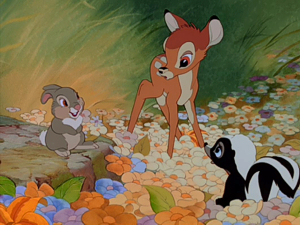
Set in a typically non-descript Disney-animated forest, seen in such films as Snow White and recycled again for sequences in The Sword In the Stone and The Black Cauldron, Bambi begins with a gorgeous Multiplane Camera shot that sets up the tone and story in a fine way. A surprisingly introspective film, Bambi arrived at a time in Walt’s career when he seemed to be out to please his audiences while satisfying the artist within him. Following the huge success of Snow White, he released Pinocchio in little more than two years afterward, and the immensely personal Fantasia soon after. Both films offered darker, or too-“highbrow” accounts of what audiences expected, and coupled with the War, Disney found himself stuck between a rock and a hard place. A popular book, Bambi seemed the right way to go, and the animal-heavy plot looked like it would finally play like another Snow White.

But Bambi is a very serious film, perhaps the most serious of all Walt’s animated productions, and though it has become known as being an often overlooked little story of friendly, cute forest creatures, it does take in some pretty Big Themes, not least the aforementioned “circle of life” from birth to death, as well as the compassion of animals versus the inhumanity of humans. “Man…was in the forest” goes one of the film’s most memorable – and chilling – lines. The poetic tone of the treatment of the story also adds to Bambi’s wistful nature; sure there are some fun sequences – Bambi on the ice never fails to raise a laugh – but the overall pace screams “mood” from every frame. It’s almost as if the animals need not speak – their amazingly naturalistic gestures, conveyed in the expert animation of their faces brought on by hours of the animators’ study of real-life deer housed at the Studio, tell everything that is needed to know, and the film’s most powerful element – the “villainy” of man – is never actually glimpsed on screen.

If there is one flaw in Bambi, it’s in the abrupt change of pace from when the young deer is told, in the other of the film’s spine-tingling lines, “Your mother can’t be with you any more…” by the Great Prince, signalling the famous end of his mother’s life. After this powerful moment, drawn and played with maximum impact, the scene fades out and we shoot rather quickly to the next year and the hap-hap-happy tunes of springtime. It’s a moment that has never sat well with me, and there is an argument for extending the pace of the fade out here, allowing for the shock to settle in (the LaserDisc pressing used to help matters, the side break appearing at this point on the CAV edition, allowing for the extra pause).
But this is one minor nit-pick with what is, in all other terms, a masterfully told story and an excellently produced movie. That the main characters, being animals, are fully rounded is another example of how personality animation had come on at Disney’s, the marriage of artist and voice talent being a deciding factor in whom the classically remembered characters would be. Obviously, the younger Thumper is the breakout star, being by turns overly cutesy and hysterical at the same time. Voiced by Peter Behn, Thumper’s success clearly owes a lot to the young lad, who fills the character with life and provides a massive springboard for animators Frank Thomas and Ollie Johnston (who cover Bambi well in their books on Disney animation) to create several instances of “business” for the rabbit, making him no less sincere in the process, and eventually expanding his role throughout the production, making him Disney’s first real scene-stealing comedy sidekick.

Older Thumper is made fun by his Mickey Rooney-esque tone and “hello fellows!” demeanour, his meeting of Miss Bunny for the first time being especially memorable (though whether they’d get away with the “stiff gag” now remains to be seen)!
Of the other characters, Friend Owl (voiced by Bill Wright) is the standard Disney wise old bird that would anonymously reappear in several features under different guises and with slightly different designs, while the Great Prince is as distant as he is meant to come off as. Fred Shield’s voice in the role commands attention, while Bambi’s skunk friend Flower (a name comically awarded by mistake), in his older incarnation, took three voices to get right (one of which was long-time vocalist Sterling Holloway, speaking only a few lines here). Indeed, it is the first half of the film for which Bambi is most famous – the cute character side that epitomises childhood and the sweet and innocent things that go along with it.
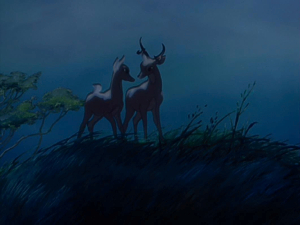
True that Bambi is more successful in its first half, where the skilful and dramatic storytelling meshes well with the light and playful comedy, but there’s no mistake in why the Studio continues to push this aspect of Bambi in promotional materials, and as to why the redundant (even if it didn’t embarrass itself artistically) made for video sequel dwells on the pre-adolescent forest animals – cute ‘n’ cuddly sells. But the second half – post the highly stylised and, for me, too drawn out I Bring You A Song interlude – features just as much stunning work: the character shading of the leads, the stag fight, the forest fire, painted uniquely without inked outlines, and the banter delivered in the witty dialogue.
Often touched upon as being Walt’s “favorite animated picture”, he knew that the story demanded his artists to jump one more step up in terms of quality and pushed the film back from what he wanted to be his second picture. Though it drops one character from the book and introduces others, the intent of this story of love, loss, growth and renewal is kept intact, and the film went on to receive three Academy Award nominations, among them Best Score (for Frank Churchill and Edward Plumb’s still haunting music) and Best Song for Love Is A Song and not the film’s main theme, Little April Shower, as is often incorrectly stated.
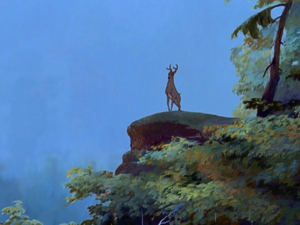
Due to the various conditions surround its eventual release, Bambi naturally, and almost as if it was expected, failed in its original theatrical issue. But, as with most of the classic films we look back upon today, the film has become monumental in Disney’s legacy (proving what a critical and audience pleasing success it was, Bambi actually began to make its money back quite quickly, during its 1947 re-issue). After the one-two-three artistic punch of his first three films, Walt proved with Dumbo that he still had the cartoon vitality that had propelled the short subjects before. With Bambi, he expertly harnesses the best of both worlds, coupled with exquisite animation from the best in the business, working at the top of their game.
In fact, it can be argued that, for whatever weaknesses it may contain, Bambi was the last of the truly Golden Age feature films to emerge from the Walt Disney Studios, and an absolutely essential addition to any animation aficionado’s Blu-ray library.
Is This Thing Loaded?
As always with Disney’s Blu-ray upgrades, there is likely to be as much lost from previous releases as there is gained, and Bambi is no exception. These new releases (in this case a jump from a DVD Platinum to a hi-def Diamond badge) usually rest back on the most recent DVD version, but Bambi hasn’t been reissued since that Platinum double-disc set from six years ago. So far, the Diamond sets have been frustrating in what they have dropped in addition to some of their sparseness, but you’ll be please to hear that Bambi is largely intact, and even boasts a couple of unexpected enhancements to previous material…

Of course this being a Disney disc, we’re treated to the usual Sneak Peeks, which over both discs in this set, include the trailer for the new Winnie The Pooh feature, Tangled, The Lion King (in what looks to be the first time in its native 1.66:1 negative ratio), and an upcoming Bambi II: Special Edition among some others. The main menu is extremely evocative of the feature itself, with a lush and splendidly enhanced suite of music and effects from the film playing continuously. Strangely, an Info option on the menu plays the usual Studio disclaimer and some copyright information, which can easily be skipped, begging the question of why this wasn’t placed within any of the other usual spots, such as before the movie plays.
Selecting Play on the set’s lone Blu-ray Disc brings up a selection of options, including a welcome new Introduction By Diane Disney-Miller (1:05) sets up the feature nicely, as she further strengthens the ties between her father’s legacy and the company that now bears his name, touching on the still new Disney Family Museum and Walt’s own feelings towards this particular film.

The Play option also offers the chance to fill in the sides of Bambi’s original 1.37 Academy framing with the DisneyView widescreen choice. Although some of the backdrops do compliment some scenes, they again bring attention to themselves whenever the camera moves, or a color tone occurs in a cut that can’t be matched quickly enough, which is why I remain a non-fan, even if I can appreciate the intention of the otherwise pleasant artwork, here provided by Studio artist Lisa Keene.
The real highlight of the original Platinum set – and a groundbreaking feature at the time that suggested the kind of interactive experiences that Blu-ray potentially promised and has since delivered – was a chance to “sit in” with Walt and his artists during the feature, in an elaborately crafted visual commentary track that charted the development of the film. That feature has been carried over here, now presented as a Inside Walt’s Story Meetings: Enhanced Edition, running the entire length of Bambi. Originally introduced by Patrick Stewart (as a tie-in to the video sequel that he voiced a character in), he’s been replaced here by a new narrator who sets up the Story Meetings concept and what we’re about to see during the opening titles, which nicely cue in photos of the prominent artists as their names appear in the credits. As before, the result runs almost like a commentary track in reverse!
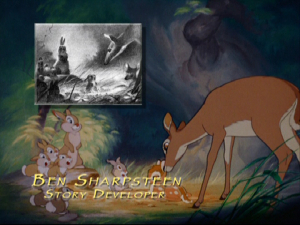
The best “director’s comments” are usually made after a long time has passed between the making and releasing of the picture, unlike the multitude of tracks nowadays which are recorded while the film is still in production. With these story meetings, the entire dialogue took place before a frame of the movie was shot, lending the track a unique perspective. It seems Walt – ever the archivist – had a stenographer record the minutes of each Bambi story conference as they happened, and these notes have been recorded by amazingly authentic actors. But these voices haven’t just been matched to the picture – no, it gets even better than that! An entirely second version of the film, compressed to disc just as well as the original feature, plays out, with original artwork, stills, photos, rare footage, typed notes, musical staves and story sketches all matched up as the feature plays along in the background, or picture in picture.
Often, there’s so much to be taking in that your pause functions will come in more than handy, but this is an exceptional ride that remained one of the very best features I ever witnessed on a DVD, and which has only been made better in its debut on Blu-ray, completely re-created and now presenting the material in a 1.78:1 widescreen frame, making it feel fresh and new all over again. Made possible by the film’s relatively short running length of just under 70 minutes, the Bambi Story Meetings is an exceptionally conceived and executed option, and as before seemed to me to be much preferable than an audio-only track composed of archive (and often hard to make out) interviews. A fantastic substitute for an actual commentary with Walt, it’s only made all the more magical by having voice actors portray the creators of the film (and who are all noted onscreen as they speak) with such an unassuming nature, that one totally buys that this is Walt and company talking – I got shivers more than once!

Those that experienced this on the Platinum set of before should also consider a revisit: the new enhancements follow recent Disney BDs that place extra content within the commentary tracks, providing tangents off onto extra tracks of information via additional clips, in this case additional material about the story meetings, deleted characters and scenes, preparation for Bambi’s visuals, its style, animators, music, and reference-specific Disney shorts Canine Caddy and On Ice. Some of this material is accessible elsewhere, but it makes for interesting viewing within the context of the feature, especially considering Walt and his associates’ comments. If the Story Meetings were good before, they’re excellent now; the new presentation well worth checking out again. Brilliant!
Also new to Bambi, and new to Disney BDs in general is Disney’s Second Screen, which attempts, through the power of the internet, to sync up your BD player to virtual content. In this case, that basically means a lot of “activities” that most collectors won’t be interested in, and otherwise a closer look at a heap of artwork, much of it of the concept variety that fills the Story Meetings presentation, and thank goodness for that, because just as with Fantasia’s Virtual Vault, this proves to be a gigantic letdown. Geared almost exclusively towards those with iPads, it does work with a Windows PC as well, with both automatic and manual sync modes (for those without microphone inputs), but although the concept sounds promising, what happens when Disney loses interest in Second Screen and deletes the material offline?

Again, there’s additional video clips – including a very cool “flipbook” of Friend Owl – only accessible online, and quite how you’re supposed to stay in sync or actually watch the movie when much of the material to explore is freeform remains a mystery to me for the few minutes I was able to spend toying with the feature, which requires activation via the Disney Movie Rewards code found within the case. It’s actually quite neat, but again this was the kind of thing that we were promised Blu-ray would provide right on the discs. BD may well be the last deliverable home video format, but that’s all the more reason to place such content on the darned discs than to make us jump through internet-connected hoops in order to enjoy it, especially when non iPadders probably have their home theater and home computer set-ups in different rooms.
Accessible from the Story Meetings presentation and also from their own Backstage Disney menu selection are a pair of Deleted Scenes, which are handily placed in context by animation historian Charles Solomon. Two Leaves (3:08) explores the development (rather than being an actual deleted moment) of a scene that Walt wanted to carry over from Salten’s original book. Nicely brought to life via newly animated story sketches, Walt was absolutely right to drop the moment from the film, as not only a tonal shift in the overall feature but a story-halting spot that could have stopped the film in its tracks with an unexpected random moment. Bambi Stuck On A Reed (1:56) is more of a usual removed moment, again brought to life from original story art (with pseudo-Walt narration) and deleted to keep the pace up even though it’s quite sweet. Finally, the deleted song Twitterpated (1:53) doesn’t refer to the social messaging phenomenon, but to Friend Owl’s coined phrase for falling in love, here newly recorded by someone trying a little too hard. Too comical, it’s clear why it was dropped in favor of Bambi’s more lyrical approach.

Presented in much the same way as the recent Fantasia images, an in-depth collection of Interactive Galleries provide us with an exhausting (but also over-cooked) exploration of Bambi concept, design, backgrounds, storyboards and production photos. The plethora of options in the way these photos can be accessed (big, small, with music, without, by topic) and even personally rated is over the top, but I’m thankful that they’re full-screen and able to be stepped through with a real opportunity to look at each image up close and in detail. The Disney Big Book Of Knowledge: Bambi Edition looks like it could be an interesting and informative look into Bambi’s forest world for families, but as a primarily child-orientated feature that also includes a selection of games and activities, I can’t say I was too spellbound myself even if I can appreciate that it has been put together nicely, especially the closing “sticker book” options.
That’s it for new Backstage Disney and Family Activity options, but pleasingly we have a selection – but not everything – of ported over Classic DVD Features (in standard definition) from the Platinum Edition set. Under Classic Deleted Scenes, animator Andreas Deja’s short introduction has been dropped but two short storyboard segments are intact: Winter Grass only lasts around thirty seconds, but Bambi’s First Snow, an alternate take on Bambi and Thumper’s frozen fun in which Bambi takes the lead, runs for two-and-a-half minutes, both nicely presented reconstructed with new voice recordings, though the lack of context is frustrating.
Classic Backstage Disney is where you’ll find the Platinum Edition’s centrepiece documentary, The Making Of Bambi: A Great Prince Is Born, running over 50 minutes in a Play All configuration. This six-part documentary certainly digs deep into the production of Walt’s classic: in a series of talking head interviews, we hear from such noted animation historians and filmmakers as John Culhane, Charles Solomon, Don Hahn, John Lasseter, Andreas Deja, Joe Grant, and Mel Shaw, among others, on what Bambi means to them and, of course, its production history and continuing influences (the Lion King’s debt is duly acknowledged). The lack of a linking host doesn’t present any hindrance, and the interviewees reveal much about the film, as well as heavily touching on discarded concepts.
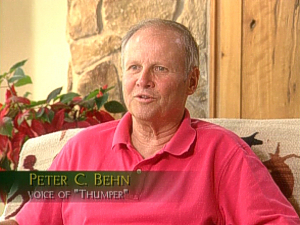
Unfortunately, Frank Thomas and Ollie Johnston were not interviewed for The Making Of Bambi, which overlooked the then last-surviving of the animators to have contributed directly to the film, though many of Walt’s Nine Old Men are shown in archival sound bites that are a little misleading in that they are not labelled as such and casual fans could be mistaken for thinking that the clips are more recent than they are. However, and despite a little overlapping from the Story Meetings, this is overall an adult, intelligently put together piece that is aimed squarely at animation admirers and collectors. Some of the anecdotes will be familiar to long-time aficionados, but they are conveyed with an enthusiasm that makes them all new again. Any documentary that locates the original voice artists and treats the film with love, true affection and respect has to be applauded – and you can’t ask for much more than that!
Next up is the often-shown excerpt from Tricks Of Our Trade (7:18, here again mislabelled as Tricks Of THE Trade), which has Walt describing the Multiplane Camera and the use it has in his animated cartoons. It’s a sequence that has been recycled on more than several occasions, and popped up in more than several Disney DVD presentations, though Walt’s pride with the camera is always apparent and he does point to Bambi’s opening as a prime example of its use, followed by a reconstruction of the crew setting up the filming of that scene. Though the clip looks as scratched and worn here as it always does (considering the usage the Studio gets from it, one wonders why a cleanup hasn’t yet been approved!), I would easily recommend the Walt Disney Treasures: Behind The Scenes At The Walt Disney Studios 2-disc set, for not only the full Tricks Of Our Trade program, but also some more background information on the Studio during the time Dumbo and Bambi were in full production.

Also pulled over is a peek Inside The Disney Archives, where Bambi fan Andreas Deja finally gets a little screentime as opposed to his numerous sightings in the Platinum set. Over these almost nine minutes, Andreas’ infectious mood quickly takes over, and we’re given a delightful tour around the vaults, where many discarded story sketches are reconstructed as Andreas talks us through some additional deleted scenes, also revealing color keys, background art and some deleted animation drawings – pure magic! The Old Mill animated short from 1937 was the “testing ground” for the Multiplane Camera, but the accompanying context information from the Platinum disc is again missing here. The Academy Award-winning short allowed the opportunity for the animators to hone their skills at portraying realistic animals, as well as the special effects of water, wind, rain and lightning, which would feature prominently in the Bambi feature. An amazingly detailed animated short (“cartoon” doesn’t do it justice at all), The Old Mill is, at well over eight minutes, probably the most ambitious of the Silly Symphony series.
Certainly it is an important film, and a true work of art, telling of what happens to a group of animals whose tranquil, creaking hideaway is disrupted by a thrashing storm. Check out some of the animals in the short, and you may well spot some Bambi supporting players! Previously available on disc two of the Walt Disney Treasures: Silly Symphonies DVD and, naturally, the Platinum Edition, I was pleased to have a copy of The Old Mill to replace my ageing VHS transfer, though I have to say that I am very disappointed it hasn’t been treated to a new high-def transfer for this release. The three-strip Technicolor elements still look to be more than a little out of alignment early in the film and the “restored” print still suffers from a lot of dirt and flutter. Not the best The Old Mill has ever looked, it’s a real shame that it couldn’t have been further cleaned up for this release – after the clarity of Bambi this looks soft and murky – even if it is a welcome inclusion. It’s a stunning film which will hopefully astonish those coming to it for the first time.
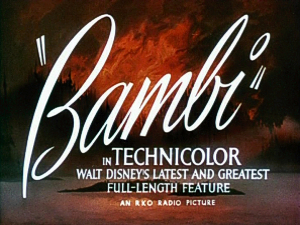
Finally – yes, finally – Bambi’s Original 1942 Theatrical Trailer, again not remastered in HD and from an unrestored print to boot, rounds things off. A rather severe narrator describes the “most powerful, gripping and romantic story ever brought to the screen”, and it’s interesting to see that, back then, it was the second, adult-half of the film that was mostly promoted to audiences. The inclusion of the trailer – something that is all too often a hit and miss affair with Disney titles, even the premium ones – must be applauded, but overall the disc, especially for a Diamond release, feels as little lightweight as the original Platinum did.
Though it neither feels particularly skewed toward the kid-audience, there are still a substantial amount of features “missing” that have been made available in the past. These aren’t even made up for on the Standard Definition DVD bundled into the package, which retains the movie, naturally, along with Disney-Miller’s introduction, the Story Meetings (with several of the new enhancements inserted in), and more kids stuff with the Platinum carried-over DisneyPedia: Bambi’s Forest Friends which, using pre-restored clips from the movie and some archive footage, looks at the real life animals to be found in Bambi’s world over four-minutes (it should be noted that this disc will be featured in a new two-disc DVD set to be released shortly after the BD debut).
WHAT’S MISSING?
Not carried over to this Diamond Edition are a number of features that, while not always a priority, might have been nice to see preserved. On the “no great shakes” list, The Forest Adventure collection of games was impressive for DVD, but has been surpassed by the Big Book activity here, and lack of a Personality Profile, read-along, Virtual Forest and peeks at video mid-quel Bambi II can’t be lamented too strongly. The featurette Restoring Bambi might now be obsolete given the new digital transfer, but going through the motions of explaining about deteriorating Nitrate negatives, the digitising and “dust-busting” of individual frames would have been appreciated.
As would the Disney Time Capsule 1942 – The Year Of Bambi, a four and a half minute clip that centered not just on achievements made at the Studio but also took in world history, culture, and Walt’s place in it all. While it revealed little new to Disney fans, it did place Bambi in context, even if the clip was happy to point out who won what at the Oscars that year but failed to mention Bambi’s three nominations, which also go unmentioned anywhere else too! The Still Frame Galleries have obviously been superseded by the new galleries here, but there was still more to see on the Platinum, including audio descriptions on selected images and, broken down into several additional sections, more developmental art, and original posters.
Going back a little further, the mid-1990s 55th Anniversary LaserDisc edition packed in a few more touches: an isolated music and effects track, an additional, much more fun – and well worth seeking out – 1988 theatrical re-issue trailer, as well a different 15-minute Making Of The Masterpiece documentary which even ended, if I remember correctly, with a deleted, alternate version of a song for the Little April Shower sequence that wasn’t included anywhere on the Platinum Edition and again hasn’t been featured here either. Of course, these additional features would be like icing on a cake, but they really would have bolstered this particular edition. The Story Meetings is excellent, but then it was before, and the lack of The Old Mill in HD is slightly embarrassing: what has been assembled here does the job admirably, but not always spectacularly.
Case Study:
Long gone, it seems, are the days of elaborate Disney packaging for their most established titles: nowadays it seems Blu-ray editions are limitedly packaged to provide basic hi-def picture upgrades and little more, the supposition, I assume, that many already have these titles on DVD and are mostly interested only in the main feature. That’s phooey, of course, but Bambi comes to BD with only the most standard of treatments: a blu-rimmed slipcase highlights the cover art, which does the job it needs to do and amusingly repeats the Roger Ebert critic’s quote that dates back as far as the film’s late 1980s VHS release.
Inside, a Blu-ray Guide lists the extras and there’s a push for other upcoming titles (including the first I’ve heard of The Fox And The Hound on BD, coupled with its DTV sequel as an extra), plus an offer for a theatrical poster reprint – Disney must have a stack of these in a warehouse somewhere as they were pulling the same promo back on the Platinum Edition release! One thing that did make me laugh, and may well be replicated on your packs: check out the “Limited Time” sticker on the front of the slipcover and see if, like on our review copy, the Great Prince has inadvertently been given Mickey Mouse’s head!
Ink And Paint:
For it’s Platinum Edition, Bambi was the beneficiary of a state-of-the-art digital cleanup by Lowry Images that restored the film to what was supposedly its original theatrical brilliance (even more brilliant than the previous two times it had been restored and released to video, apparently). In truth, Bambi was just in danger of becoming a little too bright and clean on that release, and it’s not for nothing that in the couple of times since then that I’ve watched the film, I’ve reverted to the collector’s LaserDisc for it’s more earthy tones and muted, naturalistic coloring.
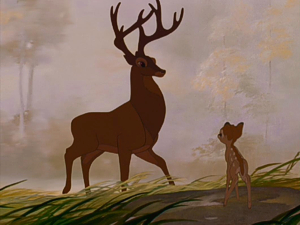
Most pleasurably, this latest restoration – the kind that Disney currently favors where original frames are digitized to represent what the film would look like had digital negatives been around in Walt’s day – redresses that balance, and returns to what must have been the film’s more intended color styling. As with Pinocchio and Snow White, this ability to really see the artwork and still make out the paint strokes helps make the film seem brand new again, and the kind of imperfections that were still inherent in the Platinum transfer (a slight “digital trail” on some fast movements for one) are now no-shows.
The shadow detail and sharpness that the old LD boasted over the DVD is back, too, as are a couple of animation glitches, previously fixed for the LD, such as Bambi’s mother’s emergence from the bushes after the first Man scare). Presented in its original 1.33:1 Academy ratio, the one switch that I wasn’t too fond off is the replacement of the original RKO distributor’s card for the 1990s blue Disney castle logo (on the Story Meetings bonus) and the current Wonderful World Of Disney styled Studio ident on the front of the film, which is a little too jarring for me, although previous pages of restoration credits for the Platinum release have been removed.
Scratch Tracks:
I was most intrigued by the packaging’s promise of a 7.1 DTS track (!) which sounded a little like overkill to me, considering that Bambi was only ever a mono release to begin with and even widening such sound to 5.1 channels often seems a redundant attempt. As expected, the result on isn’t going to shake the room or knock your socks off, but a subtle placing of several effects does “open up” the film a little more and it sounded less processed to me than the Dolby Surround LaserDisc and Disney Enhanced DVD. But it’s not all perfect – as usual with these endeavors, the track exhibits some instances of “phasing” in the music, and the stereo-spaciousness does sound a little “boxy” in the choral reproduction.

But purists needn’t worry: the original (cleaned-up) mono track is present and correct here too, and taking into account that one of Bambi’s Oscar-nominations in 1942 was for Best Sound recording, one would think that the original track could cut the mustard with today’s audiences – and it does. While I did appreciate the work gone into the 7.1 mix, the original mono track, though obviously contained to the front speaker only, just felt like it had more fidelity, brightness and even dynamics, without the compressed sound of the music and more in keeping with Bambi’s production era. French and Spanish 5.1 dubs and subs are also included on the BD and the DVD, and the disc is interestingly encoded for all regions (A, B and C)…a first for a classic catalog title?
Final Cut:
The lack of an alternate way to access the material that pops up during the enhanced Story Meetings presentation is an unfortunate aside to this otherwise excellent new edition of one of Walt Disney’s defining moments. Bambi is the film that has delighted – and frightened – generations, and perhaps the closest the Studio ever got to balancing the mix between art and mass-audience pleasing narrative structure. That some supplements are “missing” shouldn’t be a great surprise, but then we can’t really forgive the omissions either, though making up significantly is the new spotless, and most importantly not overly bright or saturated in color, transfer, with an audio restoration that’s interesting if not always successful in its aims.
Bambi was the last of that opening series of important Disney films that saw the Studio establish itself as the masters of the medium for at least five decades or so, and this Diamond Edition is a fitting tribute, as was the Platinum before. The Story Meetings “commentary” really does remain an outstanding contribution in understanding the way Walt worked at his Studio during this most creative period and the closing of the Golden Age, and the new presentation – on top of the new restoration – should be reason enough for those who enjoy or work in animation in general to upgrade to the HD format. As with the Platinum before it, this Diamond Edition doesn’t quite reach the heights of previous titles, but as far as the film itself goes: for anyone who just likes charming stories turned into great movies, Bambi is simply a must!
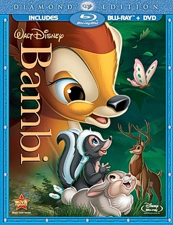 | ||
 |







